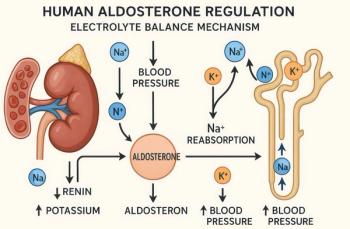
Ventricular Tachycardia in Acute Myocardial Infarction
A 67-year-old woman arrived via ambulance in ventricular tachycardia. She had been experiencing crushing substernal chest pain and shortness of breath that had worsened over the past several hours. She received oxygen (by mask) and lidocaine (100 mg intravenously) en route to the emergency department (ED), but there was no change in the rhythm.
Figure 1 – The
wide-complex tachycardia
seen on the ECG obtained at the patient’s arrival in the emergency department, with a rate of 180 beats per minute and a leftward axis, suggests ventricular tachycardia.
Figure 2 – This ECG, obtained after cardioversion with 150 J of biphasic energy, shows
normal sinus rhythm,
with a rate of 90 beats per minute and normal intervals. Note the ST-segment elevation in V
1
through V
4
, consistent with an acute anteroseptal wall infarct. The ST-segment depression in leads II, III, and aVF and laterally in leads V
5
and V
6
is consistent with ischemia.
A 67-year-old woman arrived via ambulance in ventricular tachycardia. She had been experiencing crushing substernal chest pain and shortness of breath that had worsened over the past several hours. She received oxygen (by mask) and lidocaine (100 mg intravenously) en route to the emergency department (ED), but there was no change in the rhythm.
The patient had several risk factors for coronary artery disease: hypertension, hyperlipidemia, a multiple pack-year smoking history, and a previous myocardial infarction (MI). Multiple medications had been prescribed, but she did not take them regularly.
In the ED, she was somnolent but arousable, with a heart rate of 230 beats per minute and blood pressure of 96/70 mm Hg. An ECG revealed a wide-complex tachycardia (
After the procedure, her mental status and vital signs improved. A second ECG revealed an anteroseptal MI (
The patient was taken to the catheterization suite for possible cardiac stent placement.
OVERVIEW OF VENTRICULAR TACHYCARDIA
Ventricular tachycardia is defined as a rhythm with a widened QRS duration (more than 120 milliseconds) and a rate greater than 100 beats per minute-usually greater than 150 beats per minute. The rhythm is typically regular, and the QRS axis is constant. To qualify as sustained ventricular tachycardia, the cycle must last longer than 30 seconds; when this happens, hemodynamic collapse becomes more likely and treatment should be considered.1
At times, ventricular tachycardia can be confused with supraventricular tachycardia with aberrancy.2,3 It can be difficult to distinguish between the 2 rhythms in an emergency situation. However, in a patient such as this woman, with chest pain, hemodynamic instability, and a wide-complex tachycardia, ventricular tachycardia is most likely and immediate cardioversion should be performed.
VENTRICULAR TACHYCARDIA IN MI
Structural abnormalities in the coronary arteries are the cause of 80% of fatal arrhythmias. In the presence of coronary disease, ventricular tachycardia is a marker for increased risk of sudden death from arrhythmia.4 Ventricular tachycardia leads to hemodynamic instability and syncope and puts the patient at high risk for subsequent arrhythmias.
Ventricular tachycardia occurs in 10% to 40% of patients with an acute MI.5 Infarct scar tissue sets the stage for a reentry circuit that can lead to ventricular tachycardia (other complications of MI are listed in the Box). Recent evidence has suggested that even newly ischemic areas can create the conditions for such a stable reentry circuit.1,6
Two studies have shown that ventricular tachycardia in the early phase of an acute MI is associated with significant myocardial damage. It is also associated with increased in-hospital mortality, thus underscoring the importance of early aggressive therapy.1,6 Late-occurring ventricular tachycardia is more common with a transmural infarction and is associated with 40% to 50% in- hospital mortality.5
TREATMENT
Emergency treatment of ventricular tachycardia begins with assessment of the airway, breathing, and circulation. If possible, premedication before cardioversion is recommended. However, if the patient is unstable and shows signs of hypotension and altered mental status, proceeding directly to cardioversion is advised.7
Synchronized cardioversion begins with 100 J of monophasic energy or the clinical equivalent of biphasic energy. (The synchronized mode needs to be used in ventricular tachycardia; otherwise, defibrillation may cause the rhythm to deteriorate to ventricular fibrillation or asystole.) If the rhythm is unresponsive to 100 J, the energy is increased to 200 J. This process is repeated again if necessary, increasing the energy by 100 J (to a maximum of 360 J).
Once sinus rhythm has been restored, an ECG documents the current rhythm and helps identify the cause of the arrhythmia, such as ischemia, injury, or prolonged intervals (this last may suggest an electrolyte disturbance). As soon as a cause is identified, appropriate treatment can be initiated. If ischemia or injury is detected, an interventional cardiologist should be consulted to discuss reperfusion strategies-either percutaneous angioplasty or thrombolysis.2
OUTCOME OF THIS CASE
Here an ST-segment elevation MI was noted on the ECG obtained after cardioversion (see Figure 2). The patient was treated with aspirin, β-blocker therapy, and nitroglycerin, and an interventional cardiologist was consulted. A cardiac catheterization was performed immediately: the mid-left anterior descending artery was completely occluded; a stent was successfully placed. The left circumflex artery had moderate disease, and the right coronary artery was 90% occluded. The ejection fraction was 20%, and signs of a ventricular aneurysm (see Box) were evident.
A second procedure was performed to stent the right coronary artery lesion, and because of the left ventricular aneurysm and low ejection fraction, an automatic implanted cardiac defibrillator was placed. The patient did well in her hospital course and at later follow-up continued to do well.
References:
REFERENCES:
1.
Mont L, Cinca J, Blanch P, et al. Predisposing factors and prognostic value of sustained monomorphic ventricular tachycardia in the early phase of acute myocardial infarction.
J Am Coll Cardiol.
1996;28:1670-1676.
2.
Wellens HJ, Bar FW, Lie KI. The value of the electrocardiogram in the differential diagnosis of a tachycardia with a widened QRS complex.
Am J Med.
1978; 64:27-33.
3.
Isenhour JL, Craig S, Gibbs M, et al. Wide-complex tachycardia: continued evaluation of diagnostic criteria.
Acad Emerg Med.
2000;7:769-773.
4.
Huikuri HV, Castellanos A, Myerburg RJ. Sudden death due to cardiac arrhythmias.
N Engl J Med.
2001;345:1473-1482.
5.
Zipes DP, Libby P, Bonow RO, Braunwald E, eds.
Heart Disease: A Textbook of Cardiovascular Medicine.
7th ed. Philadelphia: WB Saunders; 2005.
6.
Hatzinikolaou-Kotsakou E, Tziakas D, Hotidis A, et al. Could sustained monomorphic ventricular tachycardia in the early phase of a prime acute myocardial infarction affect patient outcome?
J Electrocardiol.
2007;40:72-77.
7.
Cummins RO, ed.
The ACLS Provider Manual.
Dallas: American Heart Association; 2004.
8.
Zimetbaum PJ, Josephson ME. Use of the electrocardiogram in acute myocardial infarction.
N Engl J Med.
2003;348:933-940.
Newsletter
Enhance your clinical practice with the Patient Care newsletter, offering the latest evidence-based guidelines, diagnostic insights, and treatment strategies for primary care physicians.



















































































































































































































































































